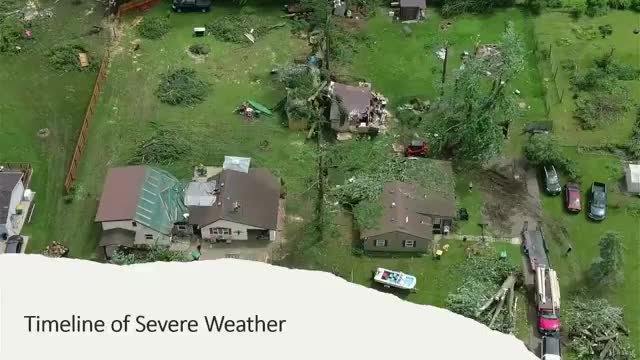Severe storm devastates Janesville as emergency response unfolds
June 27, 2024 | Rock County, Wisconsin

This article was created by AI summarizing key points discussed. AI makes mistakes, so for full details and context, please refer to the video of the full meeting. Please report any errors so we can fix them. Report an error »

A severe weather event struck the southern part of Janesville over the weekend, leading to significant damage and prompting local authorities to declare a state of emergency. The storm, which included a tornado classified as EF2 with peak winds reaching 150 miles per hour, resulted in extensive road closures and left approximately 1,000 customers without power.
During a government meeting, officials reported that the storm caused damage across a 6.2-mile path, with assessments indicating that around 380 homes and businesses were affected. Notably, three structures were completely destroyed, including a multi-unit apartment building, while 54 sustained major damage. Fortunately, there were no reported injuries, a fact that officials highlighted as remarkable given the extent of the destruction.
Emergency response efforts were coordinated through a unified command, with various agencies, including the Rock County Sheriff's Office and Human Services, actively involved in assessing damage and providing assistance. Door-to-door checks were conducted to ensure the safety of residents, and a joint press conference was held to disseminate information to the public.
In addition to tornado damage, the village of Orfordville experienced severe flooding, overwhelming its wastewater treatment plant, which was designed to handle 400,000 gallons per day but faced an influx of approximately 1.4 million gallons. This led to flooded basements in around 50 to 60 homes, with one foundation collapsing.
As recovery efforts continue, officials are working to secure funding through the Wisconsin disaster fund, which may cover up to 70% of eligible expenses. However, challenges remain, as some areas may not meet the necessary thresholds for assistance. Public works crews have been actively clearing debris and assessing infrastructure, with ongoing documentation of damages to support funding applications.
The community response has included support from organizations like the Salvation Army and the Red Cross, with calls for additional donations, particularly bottled water for affected residents. As assessments and recovery efforts progress, officials remain focused on ensuring the safety and well-being of the impacted communities.
During a government meeting, officials reported that the storm caused damage across a 6.2-mile path, with assessments indicating that around 380 homes and businesses were affected. Notably, three structures were completely destroyed, including a multi-unit apartment building, while 54 sustained major damage. Fortunately, there were no reported injuries, a fact that officials highlighted as remarkable given the extent of the destruction.
Emergency response efforts were coordinated through a unified command, with various agencies, including the Rock County Sheriff's Office and Human Services, actively involved in assessing damage and providing assistance. Door-to-door checks were conducted to ensure the safety of residents, and a joint press conference was held to disseminate information to the public.
In addition to tornado damage, the village of Orfordville experienced severe flooding, overwhelming its wastewater treatment plant, which was designed to handle 400,000 gallons per day but faced an influx of approximately 1.4 million gallons. This led to flooded basements in around 50 to 60 homes, with one foundation collapsing.
As recovery efforts continue, officials are working to secure funding through the Wisconsin disaster fund, which may cover up to 70% of eligible expenses. However, challenges remain, as some areas may not meet the necessary thresholds for assistance. Public works crews have been actively clearing debris and assessing infrastructure, with ongoing documentation of damages to support funding applications.
The community response has included support from organizations like the Salvation Army and the Red Cross, with calls for additional donations, particularly bottled water for affected residents. As assessments and recovery efforts progress, officials remain focused on ensuring the safety and well-being of the impacted communities.
View full meeting
This article is based on a recent meeting—watch the full video and explore the complete transcript for deeper insights into the discussion.
View full meeting
